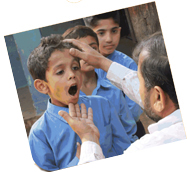Introduction
 In Jan 2005, NCHD launched an integrated ‘School Health Program’ with limited resources provided by an international donor Bill and Melinda Gates Foundation. The program was based on the premise that poor health is an important underlying factor for poor classroom performance and early school dropout. The School Health Program (SHP) thus aimed at increasing learning ability of primary school students through identifying and addressing the common health related learning impediments. It actively involved district health and education department, parents, community volunteers, philanthropists, public sector physicians, NGOs etc. In Jan 2005, NCHD launched an integrated ‘School Health Program’ with limited resources provided by an international donor Bill and Melinda Gates Foundation. The program was based on the premise that poor health is an important underlying factor for poor classroom performance and early school dropout. The School Health Program (SHP) thus aimed at increasing learning ability of primary school students through identifying and addressing the common health related learning impediments. It actively involved district health and education department, parents, community volunteers, philanthropists, public sector physicians, NGOs etc.
Program Profile
 During 2005-07, the School Health Program was initially conducted by NCHD in 16 districts of Pakistan; 03 from NWFP, 05 from Punjab, 04 from Sindh and 04 from Balochistan covering 27115 primary schools, training 69224 teachers and benefiting 2.17 million students. During 2005-07, the School Health Program was initially conducted by NCHD in 16 districts of Pakistan; 03 from NWFP, 05 from Punjab, 04 from Sindh and 04 from Balochistan covering 27115 primary schools, training 69224 teachers and benefiting 2.17 million students.
This program was then duplicated in 12 districts as part of Punjab Integrated Primary Health Care Model Program. The program period was 2007-10 and it covered 22661 primary schools, having 65703 teachers and 2.5 million students.
Process Steps of the Program
The School Health Program has essentially the following four basic process steps:
- Capacity building of teachers to identify students with visual, hearing, dental, skin and personal hygiene problems through simple and scientific screening techniques employed by teachers.
- Establishment of referral system where primary school students identified with health problem could be referred for corrective action.
- Corrective and curative care of primary school students’ identified health problems at the established referral outlets including provision of eye glasses for students having weak eyesight.
- Formation of community support system to assist and sponsor school health initiatives at local level.
Interventions
 Developing a pool of District Master Trainers: A pool of District Master Trainers (DMTs) was trained on yearly basis in each program district for the implementation of program. Developing a pool of District Master Trainers: A pool of District Master Trainers (DMTs) was trained on yearly basis in each program district for the implementation of program.
Training of Teachers: Every primary school teacher of the program district was trained in School Health Program interventions once a year. This training equipped the teachers to conduct ‘Screening’ of their students, identify health problems, refer them for corrective action to health care providers and prepare class health report. The teachers played a pivotal role in the implementation of School Health Program.
Screening of Students: An organized, structured and periodic screening was conducted in each of these 16 districts in coordination with District Government Line Departments. The trained teachers conducted ‘Screening’ of their class students and referred them for corrective action.
Referral System: The Referral System for School Health Program, in essence, was built on the existing  health resources available within in a district. In addition to District Health Department, a number of private health care providers available in the district were also persuaded through social mobilization process to participate in School Health Program activities. NGOs like ‘Sightsavers International’ and LRBT also contributed towards the success of the program. health resources available within in a district. In addition to District Health Department, a number of private health care providers available in the district were also persuaded through social mobilization process to participate in School Health Program activities. NGOs like ‘Sightsavers International’ and LRBT also contributed towards the success of the program.
Provision of Eyeglasses: A large number of students were identified with weak eyesight. These students, their teachers or parents hardly knew of the existence of this serious health problem which was constantly affecting their academic pursuit. Eye screening camps were held by ophthalmologist/ refractionists and students identified with weak eyesight were provided with free eyeglasses.
Community Support System: Community participation was ensured through formation of a platform of “Community Support System (CSS)” at local level which assisted in program activities.
De-worming of students: At the end of first Program, it was felt that children, under Pakkistani conditions, are most likely to be infected with worms. De-worming intervention in 12 districts was thus adopted considering it to be the most effective public health service. All the students (2.18M) were de-wormed after every six months during the program period. School Health Program Brochure
| 




